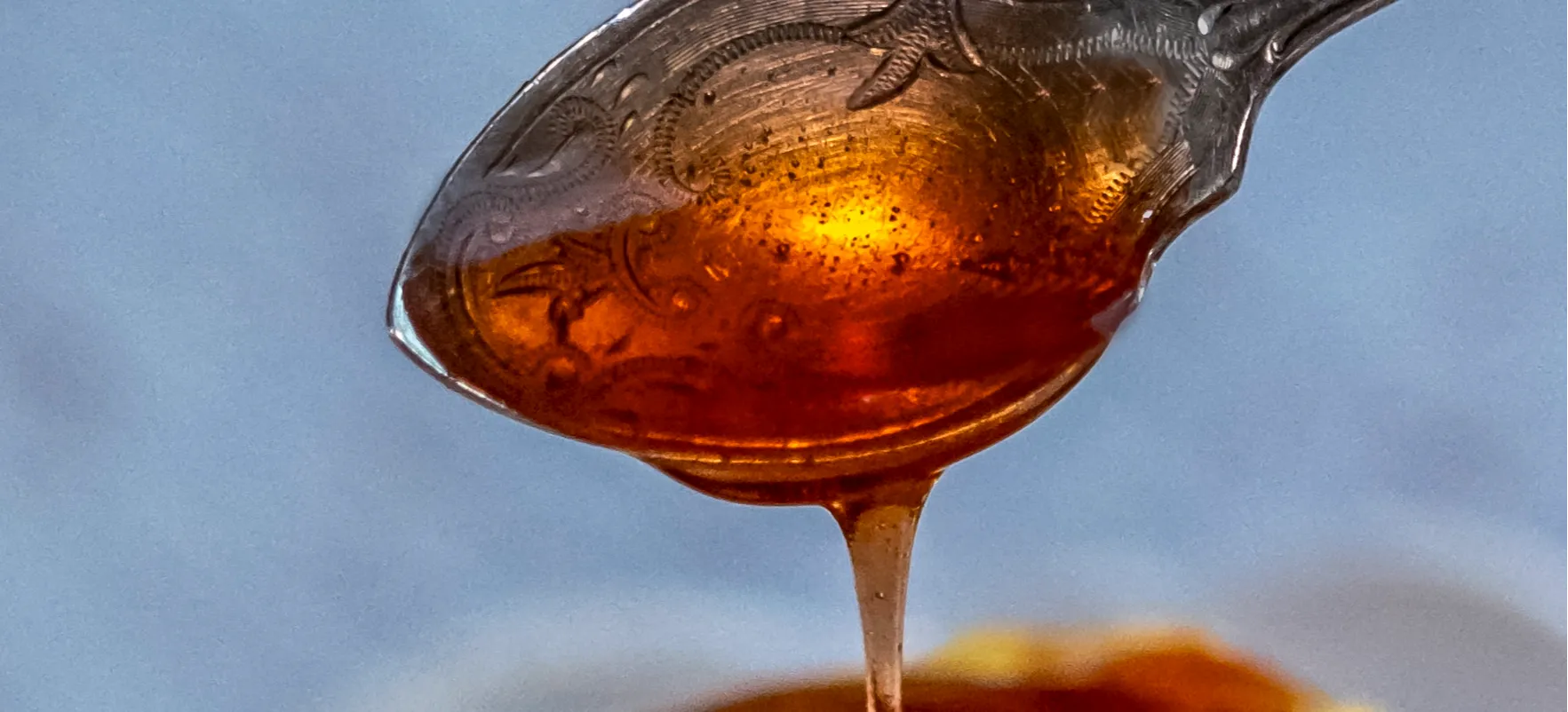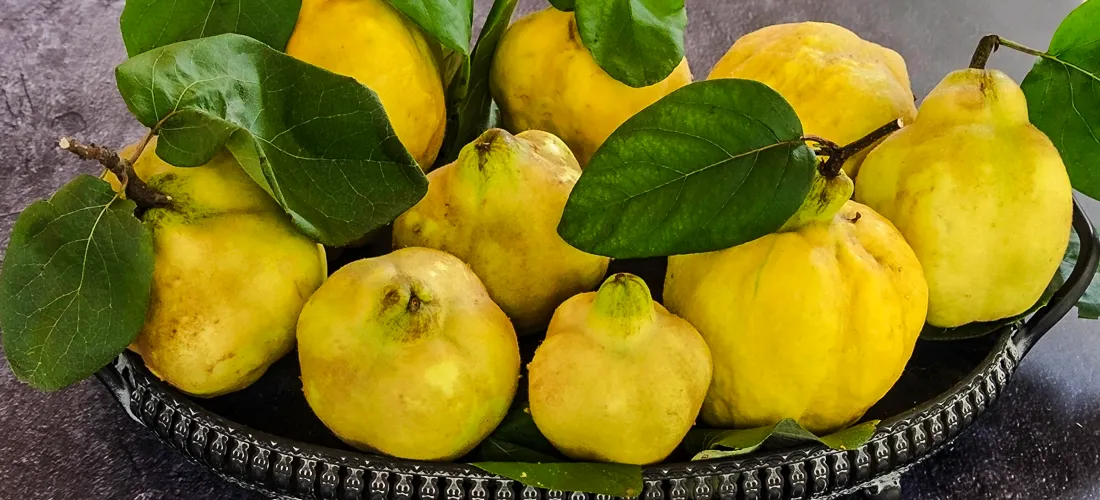Quince Honey
- Cordials, Syrups & Sweet Sauces

Quince, once only found in Grandmas’ Garden, is having a revival. Perfectly matched with the fruit honey preserving technique, their fragrance and intense translucent garnet red colour creates an outstanding syrup. It's luscious and beckons to be poured generously over waffles, pancakes or crepes, toast, crumpets, ice cream or puddings or served as an accompaniment to a raft of desserts and cakes.
Our Smyrna variety quince tree is always productive. After making jelly, chutney and paste, this quince honey is next to come out of the preserving pot. Don’t be put off by the cooking time, most of it is either the fruit mixture simmering away silently or draining. Fruit honey featured on elaborate nineteenth-century dessert tables on special occasions. They were known as “spoon sweets” as they were eaten with a spoon. Regardless of how it’s eaten, it’s a must on your preserving list.
Enjoy liberally!
- Preparation Time:
- 30 minutes + overnight draining
- Cooking Time:
- 3 hours
- Quantity:
- 2 x 500 ml bottles
PREPARATION
Warm dry sterilised sealable glass bottles and lids ready for the bottling stage

INGREDIENTS
- 2 kg
- Quinces, ripe
- To taste
- Sugar
METHOD
Wash the quinces to remove their fine down and any garden or shop debris. If using windfall quinces remove any bruised or damaged areas.
Peel, core the cut into quarters, then cut each quarter in half again. If the quinces vary in size, ensure the chopped fruit is the same size so it cooks evenly.
Transfer the fruit into a large preserving pan or heavy bottom stainless-steel pan. Just cover the fruit with water.
Place on the stove, bring to the boil and then simmer gently uncovered for approximately 3 hours or until the quinces are very pulpy. The colour of the quinces will change to a deep pink/orange.
When cooked remove from the heat. Place multiple layers of muslin cloth, cheesecloth or close-weave nylon, or any other material that will only allow the fruit juice to flow through, into a strainer and then place the strainer over another large saucepan. Gently pour the quince mixture into the strainer, cover with a clean dry tea towel or similar cloth, and allow to drain overnight.
The next day, squeeze out any remaining juice from the fruit. It should be approximately 1.2 litres. Discard the fruit. Pour the syrup into a clean preserving or heavy bottom stainless-steel pan again and bring to the boil. Regulate the temperature to maintain a steady boil until it has reduced by half and has a syrupy consistency. This step concentrates the quince flavour and brings out the natural sweetness and fragrance of the quince.
Using a large spoon remove the scum that accumulates around the side of the pan. Refer the notes section below: What is Scum
Taste the syrup and add sugar to suit your taste. Stir the mixture until the sugar has dissolved and continue to boil, stirring occasionally until it’s the consistency of a maple syrup.
Remove from heat and place on heat resistant surface.
Using a funnel, pour into warm dry sterilised sealable bottles. Fill to approximately 2.5cm (1inch) from the top and seal.
-
Due to the low sugar content of the syrup, process the bottles using a water bath, Fowlers Vacola, or equivalent method. Refer Notes section below: Preserving Method
Remove from the heat when the process has finished.
-
When cool, label and store in a cool dark place in the kitchen or pantry.
Once opened, keep in the fridge.
NOTES
- The long slow simmering stage is required to maximise the extraction of flavour, colour, and pectin.
- What is Scum
- Impurities from the fruit and sugar will rise to the surface and a fine frothy foam will move towards the edge of the preserving pan. Some fruits will produce more scum than others. This is a natural self-clarification process and makes the task of making a high-quality preserve easier.
- Removing the scum increases the preserve’s clarity. This is very important if it is being submitted for competition.
- Remove the scum before bottling. Using a stainless-steel spoon, skim the scum from around the edge of the preserving pan. Be careful to remove just the scum and not the syrup. This can be done while the preserve is boiling and/or once it has been taken off the heat.
- Do not attempt to remove the scum from the centre of a boiling pan, as there is a high risk it will splutter and hot preserve burns.
- Cooking time approximation
- The cooking time is an approximation only. Cooking time will depend upon, the size of preserving pan, degree of fruit ripeness and the degree of heat when cooking.
- Good quality jars
- Good quality jars should be used in all preserving, particularly when they are processed in a hot water bath. Thin jars often cannot withstand the temperatures and may crack either in the water bath or after removal. Avoid the disappointment and invest in good jars from a homewares or preserves outlet.
- Select jars that have non-reactive lids as the vinegar solution can cause the lids to rust over time.
- Preserving Method
- Place sealed bottles in Fowlers Preserving Unit or equivalent. Each unit is likely to have their own recommended process. Please follow the appropriate process for your unit.
- The following method is for the Fowlers Vacola Simple Natural/Year Rounder unit.
- Cover the sealed bottle with water and set the kitchen timer to 1 hr. Switch off after one hour. The water should not boil. If boiling does within the hr, do not allow to boil for longer than 5 minutes.
- Turn off unit and remove the lid. Using the tap, draw off some hot water so the level is sufficiently below the bottles to be able to safely remove them without scalding yourself.
- Remove from hot water bath and place on a board to cool for 12-18 hrs before removing the lids. If a vacuum seal has not been created. Process a second time.
- Stock Pot Method
- Line large stock pot with a couple of thick sheets of newspaper or a cut-down cake rack. Place the bottles on the newspaper or rack, in the pot, allowing space between each bottle so they do not touch. This lining will protect the bottles from direct heat and prevent cracking.
- Cover with water, bring to the boil, and hold at gentle boil for 15 minutes.
- Turn off, remove lid, and allow to stand for 5 minutes before removing.
- If possible, remove some hot water so the level is sufficiently below the bottles to be able to safely remove them without scalding yourself.
- Remove from hot water bath and place on a board to cool
- for 12-18 hrs before removing the lids. If a vacuum seal has not been created. Process a second time.
- Variation: Apple Honey. Use the same method. The syrup will not be as perfumed or have the same colour as quince, but it’s still very morish.
